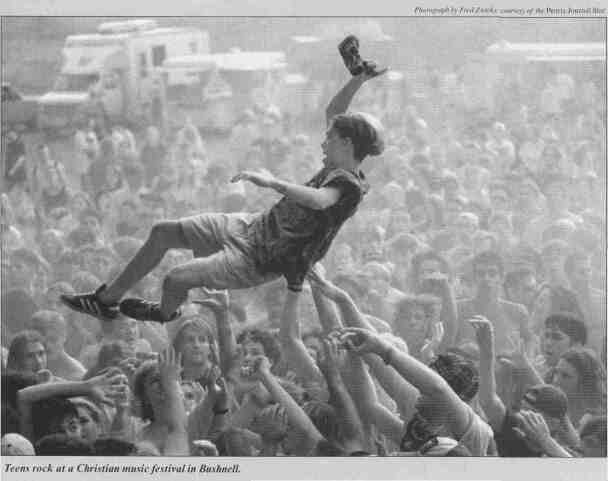|
There's no single face on youth rebellion
By Josh Bluhm
A pallid-faced crowd dressed in black gathers outside
Chicago's Metro nightclub, and draws derisive shouts
from a passing car. "Hey, where's the funeral?" mocks 26-year-old goth David Birdwell of Chicago. For Birdwell and
other goths, such vocal abuse is almost a cliche. Yet, such a
casual approach reflects the attitude of alternative groups.
Hip-hop, gangsta, grunge, punk and hippie. The gothic
scene is one of myriad youth subcultures that have
emerged, or re-emerged, at a stunning pace in recent years.
This splintered face of alternative cultures is a result of the
electronic age. The explosion in Internet use has inundated
youth with information, and given them countless opportunities to experiment with identity In 1999, there's no one face to youth rebellion.
Of course, there's a side to youth subcultures that's timeless. Adolescents have always faced simultaneous and conflicting impulses: to identify with others and assert
individualism. The dissension between mainstream society
and subcultures, including the goths, sounds as if it comes
from 1960s revolutionary Tom Hayden's Justice in the
Streets'. "As the misfits of a dying capitalism, we were
repressed in unique ways and had to rebel in unique ways."
Though ways to rebel may have evolved, the reasons to
participate in subcultures remain a constant. "Youth
identify with subcultures because they are looking for a
home, looking for the thrill, the risk of being perceived as
dangerous," says Beth Doll, an expert on youth development and a professor of educational psychology at the University of Colorado. Young people are going through
rebellion and experimentation just as previous generations
did, but today's easy access to information widely expands
the experiences available to contemporary kids, says
Nanette Potee, a professor of intercultural communications
at Northeastern Illinois University in Chicago. Such
communication barriers as time and space are shattered by
technology, and cultural distinctions between geographical
areas become more obscure.
Changes in the face of society have given room for the
computer to become a powerful influence. Many children
have both parents working, says Wheeling High School
social worker Tom Scotese. This tends to mean they look
more outside the family for identity. What they are discovering for themselves, through the infinite possibilities made available by computers, often defies easy categorization by
mainstream society.
"Youth today are more technology oriented, technology
driven. As a result, what used to be a huge division between
urban and suburban no longer exists," Potee says. "The
experience of the kids in the suburbs is, at times, not so
different from the kids in the city."
Potee calls the mosaic of youth groups "co-cultures,"
and Doll says teens may shift from one group to another.
Most subcultures are constantly in flux. Lacking any rigid
hierarchal structure, subgroups have a tendency to resist
definite labels. Any one subgroup may share features of
other groups.?
The goth scene is just one of the many subcultures that
have grown exponentially as a result of technological
advancements. Yet gothic remains a relatively loosely
defined concept. "It is difficult to say what is gothic," Bird-well says. "It is not, as portrayed by the media, an organized group with leaders. It is basically artists and creative people
who have decided not to follow the masses in letting television and fashion magazines tell them what is hip to wear this month." He adds, "We'd just rather go to the new Jekyll
and Hyde club, and laugh at the cheesy B movies and talking skeletons, than go to the ESPNzone."
Springfield Southeast High School teacher Joni Paige
says she has noticed that her students are dramatically
affected by the media images issuing from electronic
sources. She points to the response of her students in
the aftermath of the events last spring in Littleton.
"Students were just as confused and had just as many
questions about the images coming out of Columbine
|
